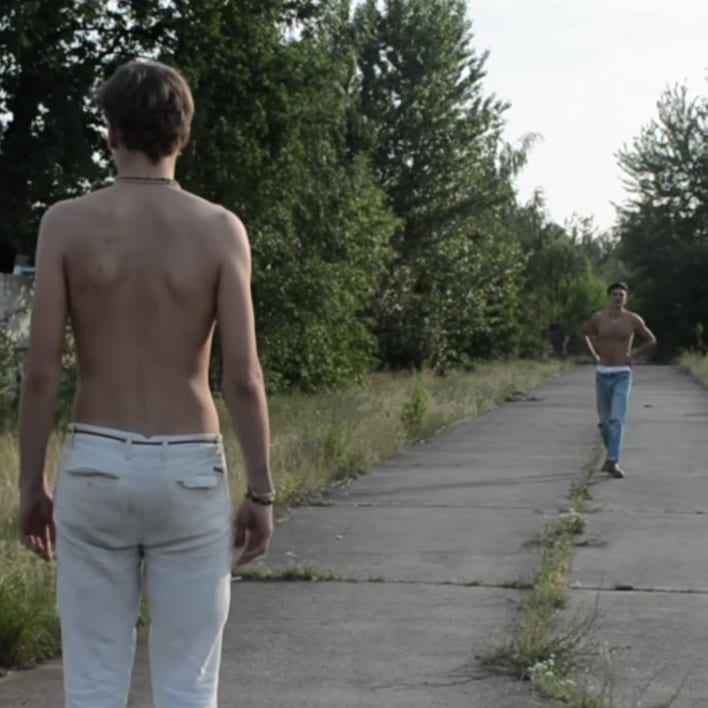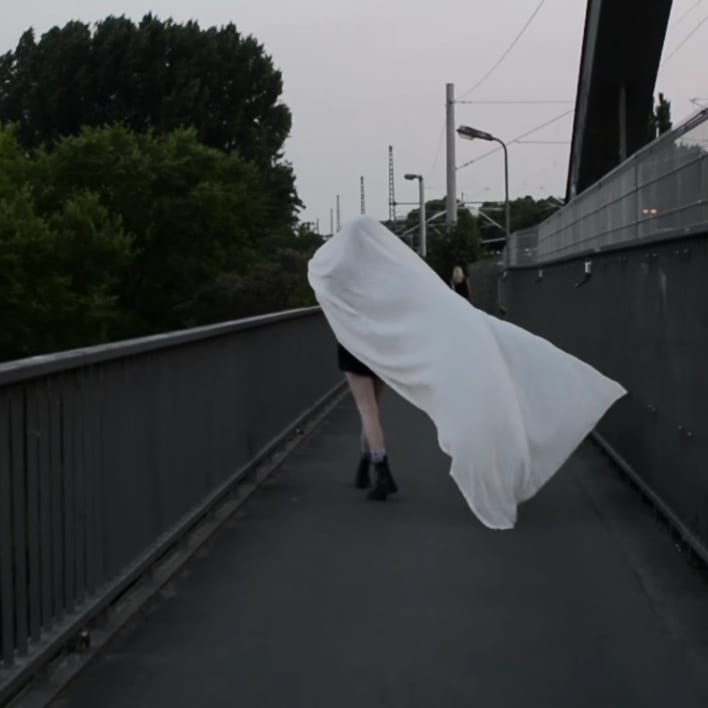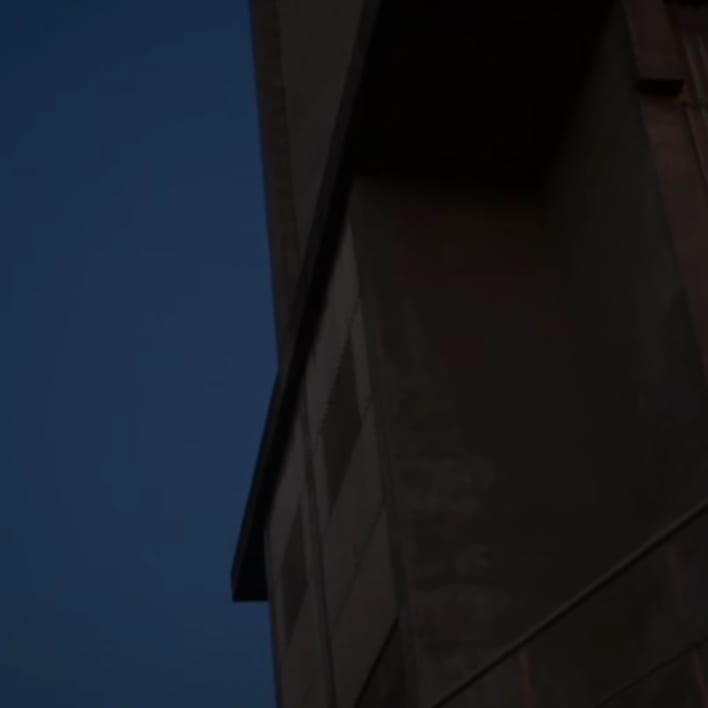Exploring the audio-visual field with a graphic lexicon of their very own, French artists Irwin Barbé and Louise Ernandez keep cementing a riveting body of work astride analogue photography and video that has seen them illustrating the works of a wide range of emerging producers and reputed artists such as Anthony Parasole, Madteo, Hold Youth, IUEKE, Syracuse, Gohan, Joey Anderson, Nummer… and many more.
After collaborating on videos such as San Proper’s ‘Deja Vu‘ and Mura Oka’s ‘A1 Untitled‘, the pair return with a superb seven minute-long, documentary-like visual composition for Dyad’s moody techno crusher ‘Zou‘. We caught up with Irwin and Louise to discuss the film’s concept and making of, photo and video aesthetics and further projects schedule.
Hey Irwin, hey Louise! Could you please introduce yourselves to our readers? How did you start working together?
We met while studying photography and video at ENSAD in Paris four years ago. We were in the same class and quickly realized that we shared similar interests and the same aesthetic vision. So we started working together on various video and photo projects, and it’s been going on since then!
You’re both photographers by trade. How did you come to turn music into moving pictures?
Irwin : I actually started with video, making short films with my friends in junior high school, then around 15, I got interested in photography. I discovered analog photography and it became more important than video. But since three years, video has become my main concern again (even though I continue taking photos), and as I’m also really interested in music, I started working on lots of music-related visual projects (music videos, video projections during parties, audiovisual performances etc).
Louise : I’ve been taking photos for ten years now, and around five years ago I began experimenting with video as well. I’m really passionate about music too, so I naturally began working with labels and musicians. I think it’s super interesting to see how images and sounds influence each other, and hopefully how one can intensify the other.
The video shows the peregrinations of several young men and women through sore after moments and sultry come-downs. Where did you meet them?
Many of the people in the Zou video are our friends or friends of friends. This was crucial for the project because we needed that intimacy feeling. These persons knew our work, and there was a feeling of trust that really helped us capture those fleeting moments. It was also super important that the people we shot had already experienced those emotions and sensations.
Zou is more of a documentary on 2015’s clubbing youth compared to your highly stylized works for Mura Oka or San Proper for instance. What was your approach when filming these young people post-party moments?
It’s true that many of our videos are pretty ethereal, and for this one we wanted to do something that was atmospheric but also anchored in a real contemporary cultural phenomenon. In general, so much of the visuals produced for techno music are totally disconnected from the reality of the movement now. All these 3D / glitch images, these videos of textures moving, these nineties/VHS film found-footage… Even if their abstractness can be interesting, these type of visuals often feel kind of sterile in the end.
How did you first get in touch with Ben Gibson and Fundamental Interaction? The video fits that ‘Zou’ track like a glove.
We met Mark (FI) and Ben via CLFT (a label created by our good friend Simon) on which they released several tracks. We had already worked together on two music videos for Fundamental Interaction, and when they sent us Zou, we were immediately inspired. The track is so powerful, the way the sounds evolve, becoming more and more detuned, the unstoppable power of the rhythm… It was the perfect track to finally cement our desire to film these special moments.
What kind of feeling did you want to convey with this short film? Was the concept born after your own clubbing experiences?
Our goal was to recreate the ambiguity of these moments : the positiveness, the euphoria, the sensory bliss but also the darker sides, the unexplainable sadness, and that feeling of confusion. The concept of the video is definitely inspired by our memories of clubbing experiences. We are thinking a lot about ways to film and photograph these moments, because their visual representation is often disappointing, as it often doesn’t match the intensity of the real experience. For us, partying is much more than basic hedonism, and it can be deeply inspiring on many levels.
We all know Berlin is the stronghold for clubbing but what would you say makes the city’s nights so special?
This question is super hard to answer, because clubbing is such a subjective experience, but what strikes us the most in Berlin (compared to Paris for example) is that partying in general seems much more accepted by the rest of the population, even by those who are complete strangers to this culture. You can take the u-bahn at 10am and even if you’re sitting next to people who are going to work, they won’t look at you in such a disapproving way. Apart from that, we think the whole mythology of Berlin nights unconsciously makes them even more intense: there’s a feeling of being part of a real community and a form of underground tradition.
From urban surroundings to more remote and natural areas, you filmed some truly beautiful places. Can you tell us more about the shooting locations and why you chose them (factory/river scenes… etc.)?
The core of the video was inspired by a strange experience we had in the beginning of the summer in Berlin. It was almost noon and one of our friends had some sort of K-hole in a club. We got out of the club, and started walking with him, aimlessly, taking care of him until he regained consciousness.
When we thought about this moment afterwards, we realized that it took us to these really fascinating places : under a concrete bridge, in an abandoned silo… We decided to structure the Zou video based on this pyschotropic roaming, by going back and filming in all these places. The factory is the only place that’s not in Berlin. It’s a huge cement factory located in the South of France, and we felt it was a good metaphor for the mental states described in our video.
It’s certainly been quite a hard task to try seizing this impalpable feeling of floating somewhere in limbo between the ecstasy of the night itself and the gloomy rise of the next day… How did you proceed to make this tangible enough to the viewer?
Dyad had spoken to us about a synaesthesia impression they had while making the track, that involved blue and red colors. It suited perfectly the light intentions we had. We pretty much just used the evocative power of dawns and sunsets, and highlighted some colors with grading afterwards.
Was it all written before being shot or more of an instant, spontaneous capture?
Actually the video is a mix of spontaneous and staged moments. We realized something strange while directing it is that the feeling of authenticity is sometimes more intense when you give directions to the people you film. Lots of people feel awkward when they’re in front of a camera because they simply don’t know what to do, and if you give them ideas they can overcome the awkwardness. But basically not much was written, we had this idea of blue hour wanderings in Berlin during the summertime, and then we just went there and improvised.
There’s some kind of paradoxical countercurrent between the acceleration of the images and editing, flowing in and around with Dyad’s heavy kicks, and that late-night/early day kind of ankylosis. Was it intentionally constructed this way?
The editing was done pretty instinctively. We tried to create a fleeting rhythm structure, that would sort of simulate the way our memory recalls those party experiences. You remember some parts very vividly, time seems expanded and some other parts become blurry and fast, like flashes.
Can you tell us more about your upcoming plans and further projects (both individually and together)?
We just finished school, and we’ve been mainly working together for about six months. Right now we are working a lot on commercial stuff, but we also have several personal projects going on : a photo series about the French Riviera, an experimental video filmed in the Balkans mountains, another experimental slow-motion video about the clubbing scene, and many other things…










